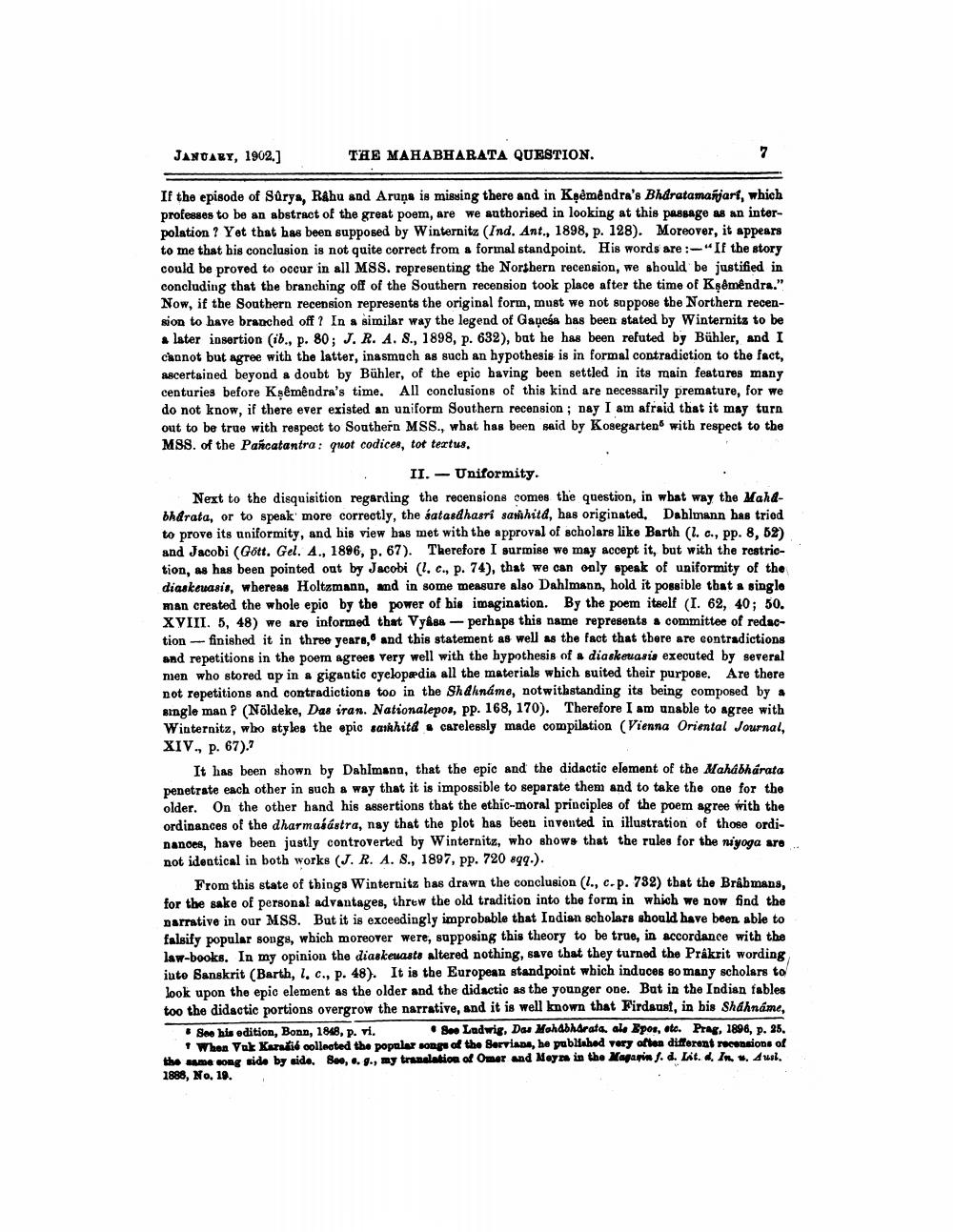________________
JANUARY, 1902.]
TAE MAHABHARATA QUESTION.
If the episode of Surys, Rehu and Aruņa is missing there and in Kşemêndra's Bharatamañjari, which professes to be an abstract of the great poem, are we authorised in looking at this passage as an interpolation? Yet that has been supposed by Winternitz (Ind. Ant., 1898, p. 128). Moreover, it appears to me that his conclusion is not quite correct from a formal standpoint. His words are:-"If the story could be proved to occur in all MSS. representing the Northern recension, we should be justified in concluding that the branching off of the Southern recension took place after the time of Kşemêndra." Now, if the Southern recension represents the original form, must we not suppose the Northern recension to have branched off? In a similar way the legend of Ganesa has been stated by Winternitz to be
later insertion (ib., p. 80; J. R. A. 8., 1898, p. 632), but he has been refuted by Bühler, and I cannot but agree with the latter, inasmuch as such an hypothesis is in formal contradiction to the fact, ascertained beyond a doubt by Bühler, of the epic having been settled in its main features many centuries before Kşêmêndra's time. All conclusions of this kind are necessarily premature, for we do not know, if there ever existed an uniform Southern recension ; nay I am afraid that it may turn out to be true with respect to Southern MSS., what has been said by Kosegarten with respect to the MSS. of the Pancatantra: quot codices, tot textus.
II. - Uniformity. Next to the disquisition regarding the recensions comes the question, in what way the Mahdbharata, or to speak more correctly, the satasdhasti sanihitd, has originated, Dahlmann has tried to prove its uniformity, and his view bas met with the approval of scholars like Barth (L. c., pp. 8, 52) and Jacobi (Gott. Gel. A., 1896, p. 67). Therefore I surmise we may accept it, but with the restriction, as has been pointed out by Jacobi (l. c., p. 74), that we can only speak of uniformity of the diaskeuasis, whereas Holtzmann, and in some measure alao Dahlmann, hold it possible that a single man created the whole epio by the power of his imagination. By the poem itself (I. 62, 40; 50. XVIII. 5, 48) we are informed that Vyâss - perhaps this name represents a committee of redaction finished it in three years, and this statement as well as the fact that there are contradictions and repetitions in the poem agrees very well with the hypothesis of a diaskeuasis executed by several men who stored up in a gigantic cyelopædia all the materials which suited their purpose. Are there not repetitions and contradictions too in the Shdanáme, notwithstanding its being composed by a single man ? (Nöldeke, Das iran. Nationalepos, pp. 168, 170). Therefore I am unable to agree with Winternitz, who styles the epio sarhit& • carelessly made compilation (Vienna Oriental Journal, XIV. p. 67).
It has been shown by Dahlmann, that the epic and the didactic element of the Mahabharata penetrate each other in such a way that it is impossible to separate them and to take the one for the older. On the other hand his assertions that the ethic-moral principles of the poem agree with the ordinances of the dharmasastra, nay that the plot has been invented in iHustration of those ordiDanoes, have been justly controverted by Winternitz, who shows that the rules for the niyoga are not identical in both works (J. R. A. S., 1897, pp. 720 899.).
From this state of things Winternitz has drawn the conclusion (I., c.p. 732) that the Brabmans, for the sake of personal advantages, threw the old tradition into the form in which we now find the narrativo in our MSS. But it is exceedingly improbable that Indian scholars should have been able to falsify popular songe, which moreover were, supposing this theory to be true, in accordance with the law-books. In my opinion the diaskeuasta altered nothing, save that they turned the Prikrit wording into Sanskrit (Barth, 1, c., p. 48). It is the European standpoint which induces so many scholars to look upon the epic element as the older and the didactic as the younger one. But in the Indian fables too the didactic portions overgrow the narrative, and it is well known that Firdaust, in his Shahnáme, • Soo his edition, Bonn, 1848, P. vi.
See Ladwig. Das Mohabharata, ale pos, oto. Prec, 1896, p. 25, When Vuk Karadié oollected the popular songs of the Serviage, he published very often different recensions of theme song side by side. Beo, .. 9., my translation of Omer and Mayn in the Magarin . d. Lit. In. . Awal. 1888, No. 19.




